Cluster Membership of Galaxies Using Multi-Layer Perceptron Neural Network
Abstract
:1. Introduction
2. Methods
2.1. Data
2.2. Galaxy Measures
2.3. Artificial Intelligence
2.4. Training
3. Results
3.1. Optimizing the Model—Experiments
3.2. Best Model and Comparison to Other Methods
4. Summary and Discussion
- We find that ML can effectively use the information beyond galaxy SED and perform better than the photometric method that is purely based on SED alone;
- The performance of our MLP model can be improved by including the non-SED galaxy parameters, such as the concentration index, galaxy iso-area, asymmetry, and ellipticity, while it is relatively less affected by the variations of the MLP model architecture;
- Our MLP model appears to be able to separate the background galaxies better than the foreground galaxies;
- Faint galaxies are somewhat harder to assign their cluster memberships even using our MLP model, though the model is more robust against the faint magnitude than other photometric methods for finding the cluster membership for the faint galaxies;
- The MLP method can achieve relatively high statistics simultaneously for both purity and completeness, which is essential for maintaining the overall cluster membership performance.
4.1. Radial Distributions of Galaxies
4.2. Radial Distributions of Galaxies in the Samples without Spectroscopic Sampling Bias
Author Contributions
Funding
Data Availability Statement
Acknowledgments
Conflicts of Interest
References
- Dekel, A.; Silk, J. The origin of dwarf galaxies, cold dark matter, and biased galaxy formation. Astrophys. J. 1986, 303, 39–55. [Google Scholar] [CrossRef]
- Oh, S.H.; De Blok, W.; Brinks, E.; Walter, F.; Kennicutt, R.C. Dark and luminous matter in THINGS dwarf galaxies. Astron. J. 2011, 141, 193. [Google Scholar] [CrossRef] [Green Version]
- Grillo, C.; Suyu, S.; Rosati, P.; Mercurio, A.; Balestra, I.; Munari, E.; Nonino, M.; Caminha, G.; Lombardi, M.; De Lucia, G.; et al. CLASH-VLT: Insights on the mass substructures in the Frontier Fields Cluster MACS J0416. 1–2403 through accurate strong lens modeling. Astrophys. J. 2015, 800, 38. [Google Scholar] [CrossRef]
- Caminha, G.; Rosati, P.; Grillo, C.; Rosani, G.; Caputi, K.; Meneghetti, M.; Mercurio, A.; Balestra, I.; Bergamini, P.; Biviano, A.; et al. Strong lensing models of eight CLASH clusters from extensive spectroscopy: Accurate total mass reconstructions in the cores. Astron. Astrophys. 2019, 632, A36. [Google Scholar] [CrossRef] [Green Version]
- Bergamini, P.; Rosati, P.; Mercurio, A.; Grillo, C.; Caminha, G.; Meneghetti, M.; Agnello, A.; Biviano, A.; Calura, F.; Giocoli, C.; et al. Enhanced cluster lensing models with measured galaxy kinematics. Astron. Astrophys. 2019, 631, A130. [Google Scholar] [CrossRef] [Green Version]
- Miyazaki, S.; Komiyama, Y.; Nakaya, H.; Kamata, Y.; Doi, Y.; Hamana, T.; Karoji, H.; Furusawa, H.; Kawanomoto, S.; Morokuma, T.; et al. Hyper suprime-cam. In Proceedings of the Ground-Based and Airborne Instrumentation for Astronomy IV, Online, 14 September 2012; International Society for Optics and Photonics: Bellingham, WA, USA, 2012; Volume 8446, p. 84460Z. [Google Scholar]
- Ivezić, Ž.; Kahn, S.M.; Tyson, J.A.; Abel, B.; Acosta, E.; Allsman, R.; Alonso, D.; AlSayyad, Y.; Anderson, S.F.; Andrew, J.; et al. LSST: From science drivers to reference design and anticipated data products. Astrophys. J. 2019, 873, 111. [Google Scholar] [CrossRef]
- Mobasher, B.; Colless, M.; Carter, D.; Poggianti, B.M.; Bridges, T.J.; Kranz, K.; Komiyama, Y.; Kashikawa, N.; Yagi, M.; Okamura, S. A photometric and spectroscopic study of dwarf and giant galaxies in the Coma cluster. IV. the luminosity function. Astrophys. J. 2003, 587, 605. [Google Scholar] [CrossRef] [Green Version]
- Agulli, I.; Aguerri, J.; Sánchez-Janssen, R.; Barrena, R.; Diaferio, A.; Serra, A.L.; Méndez-Abreu, J. Deep spectroscopic luminosity function of Abell 85: No evidence for a steep upturn of the faint-end slope. Mon. Not. R. Astron. Soc. Lett. 2014, 444, L34–L38. [Google Scholar] [CrossRef] [Green Version]
- Agulli, I.; Aguerri, J.; Diaferio, A.; Dominguez Palmero, L.; Sánchez-Janssen, R. Deep spectroscopy of nearby galaxy clusters–II. The Hercules cluster. Mon. Not. R. Astron. Soc. 2017, 467, 4410–4423. [Google Scholar] [CrossRef] [Green Version]
- Tanaka, M.; Kodama, T.; Arimoto, N.; Okamura, S.; Umetsu, K.; Shimasaku, K.; Tanaka, I.; Yamada, T. The build-up of the colour–magnitude relation as a function of environment. Mon. Not. R. Astron. Soc. 2005, 362, 268–288. [Google Scholar] [CrossRef] [Green Version]
- Trentham, N.; Tully, R.B. The faint end of the galaxy luminosity function. Mon. Not. R. Astron. Soc. 2002, 335, 712–732. [Google Scholar] [CrossRef] [Green Version]
- Chiboucas, K.; Tully, R.B.; Marzke, R.O.; Trentham, N.; Ferguson, H.C.; Hammer, D.; Carter, D.; Khosroshahi, H. Keck/LRIS Spectroscopic Confirmation of Coma Cluster Dwarf Galaxy Membership Assignments. Astrophys. J. 2010, 723, 251. [Google Scholar] [CrossRef] [Green Version]
- Molino, A.; Costa-Duarte, M.; de Oliveira, C.M.; Cenarro, A.; Neto, G.L.; Cypriano, E.; Sodré, L.; Coelho, P.; Chow-Martínez, M.; Monteiro-Oliveira, R.; et al. J-PLUS: On the identification of new cluster members in the double galaxy cluster A2589 and A2593 using PDFs. Astron. Astrophys. 2019, 622, A178. [Google Scholar] [CrossRef] [Green Version]
- Brescia, M.; Cavuoti, S.; D’Abrusco, R.; Longo, G.; Mercurio, A. Photometric redshifts for quasars in multi-band surveys. Astrophys. J. 2013, 772, 140. [Google Scholar] [CrossRef]
- Biviano, A.; Rosati, P.; Balestra, I.; Mercurio, A.; Girardi, M.; Nonino, M.; Grillo, C.; Scodeggio, M.; Lemze, D.; Kelson, D.; et al. CLASH-VLT: The mass, velocity-anisotropy, and pseudo-phase-space density profiles of the z = 0.44 galaxy cluster MACS J1206. 2-0847. Astron. Astrophys. 2013, 558, A1. [Google Scholar] [CrossRef] [Green Version]
- Angora, G.; Rosati, P.; Brescia, M.; Mercurio, A.; Grillo, C.; Caminha, G.; Meneghetti, M.; Nonino, M.; Vanzella, E.; Bergamini, P.; et al. The search for galaxy cluster members with deep learning of panchromatic HST imaging and extensive spectroscopy. Astron. Astrophys. 2020, 643, A177. [Google Scholar] [CrossRef]
- Baba, H.; Yasuda, N.; Ichikawa, S.I.; Yagi, M.; Iwamoto, N.; Takata, T.; Horaguchi, T.; Taga, M.; Watanabe, M.; Ozawa, T.; et al. Development of the subaru-mitaka-okayama-kiso archive system. In Proceedings of the Astronomical Data Analysis Software and Systems XI, Victoria, BC, Canada, 30 September–3 October 2001; Volume 281, p. 298. [Google Scholar]
- Yagi, M.; Kashikawa, N.; Sekiguchi, M.; Doi, M.; Yasuda, N.; Shimasaku, K.; Okamura, S. Luminosity Functions of 10 Nearby Clusters of Galaxies. I. Data. Astron. J. 2002, 123, 66–86. [Google Scholar] [CrossRef] [Green Version]
- Jordi, K.; Ammon, E. Empirical color transformations between SDSS photometry and other photometric systems. Astron. Astrophys. 2006, 460, 339–347. [Google Scholar] [CrossRef]
- Landolt, A. UBVRI photometric standard stars in the magnitude range 11.5–16.0 around the celestial equator. Astron. J. 1992, 104, 340–371. [Google Scholar] [CrossRef]
- Schlafly, E.F.; Finkbeiner, D.P. Measuring Reddening with Sloan Digital Sky Survey Stellar Spectra and Recalibrating SFD. Astrophys. J. 2011, 737, 103. [Google Scholar] [CrossRef]
- Chilingarian, I.; Melchior, A.; Zolotukhin, I. Analytical approximations of K-corrections in optical and near-infrared bands. Mon. Not. R. Astron. Soc. 2010, 405, 1409–1420. [Google Scholar] [CrossRef] [Green Version]
- Bertin, E.; Arnouts, S. SExtractor: Software for source extraction. Astron. Astrophys. Suppl. Ser. 1996, 117, 393–404. [Google Scholar] [CrossRef]
- Kron, R.G. Photometry of a complete sample of faint galaxies. Astrophys. J. Suppl. Ser. 1980, 43, 305–325. [Google Scholar] [CrossRef]
- Okamura, S.; Kodaira, K.; Watanabe, M. Digital surface photometry of galaxies toward a quantitative classification. III—A mean concentration index as a parameter representing the luminosity distribution. Astrophys. J. 1984, 280, 7–14. [Google Scholar] [CrossRef]
- Doi, M.; Fukugita, M.; Okamura, S. Morphological Classification of Galaxies Using Simple Photometric Parameters. Mon. Not. R. Astron. Soc. 1993, 264, 832. [Google Scholar] [CrossRef] [Green Version]
- Abraham, R.G.; Valdes, F.; Yee, H.K.C.; van den Bergh, S. The morphologies of distant galaxies. 1: An automated classification system. Astrophys. J. 1994, 432, 75–90. [Google Scholar] [CrossRef]
- Hashimoto, Y.; Oemler, A., Jr.; Lin, H.; Tucker, D. The Influence of Environment on the Star Formation Rates of Galaxies. Astrophys. J. 1998, 499, 589–599. [Google Scholar] [CrossRef] [Green Version]
- Hashimoto, Y.; Oemler, A., Jr. The Concentration-Density Relation of Galaxies in the Las Campanas Redshift Survey. Astrophys. J. 1999, 510, 609. [Google Scholar] [CrossRef] [Green Version]
- Conselice, C.J. The Relationship between Stellar Light Distributions of Galaxies and Their Formation Histories. Astrophys. J. Suppl. Ser. 2003, 147, 1–28. [Google Scholar] [CrossRef]
- Goto, T.; Yamauchi, C.; Fujita, Y.; Okamura, S.; Sekiguchi, M.; Smail, I.; Bernardi, M.; Gomez, P. The morphology-density relation in the Sloan Digital Sky Survey. Mon. Not. R. Astron. Soc. 2003, 346, 601–614. [Google Scholar] [CrossRef]
- Hashimoto, Y.; Henry, J.; Böhringer, H. Alignment of galaxies and clusters. Mon. Not. R. Astron. Soc. 2008, 390, 1562–1568. [Google Scholar] [CrossRef] [Green Version]
- Hashimoto, Y.; Henry, J.P.; Boehringer, H. Multiwavelength investigations of co-evolution of bright cluster galaxies and their host clusters. Mon. Not. R. Astron. Soc. 2014, 440, 588–600. [Google Scholar] [CrossRef] [Green Version]
- Abadi, M.; Barham, P.; Chen, J.; Chen, Z.; Davis, A.; Dean, J.; Devin, M.; Ghemawat, S.; Irving, G.; Isard, M.; et al. {TensorFlow}: A System for {Large-Scale} Machine Learning. In Proceedings of the 12th USENIX Symposium on Operating Systems Design and Implementation (OSDI 16), Savannah, GA, USA, 2–4 November 2016; pp. 265–283. [Google Scholar]
- Ramchoun, H.; Ghanou, Y.; Ettaouil, M.; Janati Idrissi, M.A. Multilayer perceptron: Architecture optimization and training. Int. J. Interact. Multimed. Artif. Intell. 2016, 4, 26–30. [Google Scholar] [CrossRef]
- Nair, V.; Hinton, G.E. Rectified Linear Units Improve Restricted Boltzmann Machines. In Icml; 2010; Available online: https://icml.cc/Conferences/2010/papers/432.pdf (accessed on 1 January 2022).
- Han, J.; Moraga, C. The influence of the sigmoid function parameters on the speed of backpropagation learning. In International Workshop on Artificial Neural Networks; Springer: Berlin/Heidelberg, Germany, 1995; pp. 195–201. [Google Scholar]
- Kingma, D.P.; Ba, J. Adam: A method for stochastic optimization. arXiv 2014, arXiv:1412.6980. [Google Scholar]
- Prechelt, L. Automatic early stopping using cross validation: Quantifying the criteria. Neural Netw. 1998, 11, 761–767. [Google Scholar] [CrossRef] [Green Version]
- O’Malley, T.; Bursztein, E.; Long, J.; Chollet, F.; Jin, H.; Invernizzi, L.; de Marmiesse, G.; Fu, Y.; Podivìn, J.; Schäfer, F. KerasTuner. 2019. Available online: https://github.com/keras-team/keras-tuner (accessed on 1 January 2022).
- Ramyachitra, D.; Manikandan, P. Imbalanced dataset classification and solutions: A review. Int. J. Comput. Bus. Res. (IJCBR) 2014, 5, 1–29. [Google Scholar]
- Kent, S.; Gunn, J. The dynamics of rich clusters of galaxies. I-The Coma cluster. Astron. J. 1982, 87, 945–971. [Google Scholar] [CrossRef]
- Zhao, J.; Shao, Z. Statistical deformation of line-of-sight velocity membership of galaxy clusters. Astron. Astrophys. 1994, 288, 89–96. [Google Scholar]
- Caminha, G.; Grillo, C.; Rosati, P.; Balestra, I.; Karman, W.; Lombardi, M.; Mercurio, A.; Nonino, M.; Tozzi, P.; Zitrin, A.; et al. CLASH-VLT: A highly precise strong lensing model of the galaxy cluster RXC J2248.7-4431 (Abell S1063) and prospects for cosmography. Astron. Astrophys. 2016, 587, A80. [Google Scholar] [CrossRef]
- Stehman, S.V. Selecting and interpreting measures of thematic classification accuracy. Remote Sens. Environ. 1997, 62, 77–89. [Google Scholar] [CrossRef]
- Sorensen, T.A. A method of establishing groups of equal amplitude in plant sociology based on similarity of species content and its application to analyses of the vegetation on Danish commons. Biol. Skar. 1948, 5, 1–34. [Google Scholar]
- Beck, R.; Dobos, L.; Budavári, T.; Szalay, A.S.; Csabai, I. Photometric redshifts for the SDSS Data Release 12. Mon. Not. R. Astron. Soc. 2016, 460, 1371–1381. [Google Scholar] [CrossRef]
- Hashimoto, Y.; Henry, J.P.; Böehringer, H. Dwarf galaxies and cluster environments. Mon. Not. R. Astron. Soc. 2018, 481, 981–999. [Google Scholar]
- Agulli, I.; Aguerri, J.; Sánchez-Janssen, R.; Dalla Vecchia, C.; Diaferio, A.; Barrena, R.; Dominguez Palmero, L.; Yu, H. Deep spectroscopy of nearby galaxy clusters–I. Spectroscopic luminosity function of Abell 85. Mon. Not. R. Astron. Soc. 2016, 458, 1590–1603. [Google Scholar] [CrossRef] [Green Version]
- Perlich, C.; Kaufman, S.; Rosset, S. Leakage in data mining: Formulation, detection, and avoidance. In Proceedings of the 17th International Conference on Knowledge Discovery and Data Mining, San Diego, CA, USA, 21–24 August 2011; pp. 556–563. [Google Scholar]
- Umetsu, K. Cluster–galaxy weak lensing. Astron. Astrophys. Rev. 2020, 28, 1–106. [Google Scholar] [CrossRef]
- Hashimoto, Y.; Böhringer, H.; Umetsu, K. Dwarf galaxy luminosity functions and cluster environments. Mon. Not. R. Astron. Soc. 2022, 511, 2796–2813. [Google Scholar] [CrossRef]
- LeCun, Y.; Boser, B.; Denker, J.S.; Henderson, D.; Howard, R.E.; Hubbard, W.; Jackel, L.D. Backpropagation applied to handwritten zip code recognition. Neural Comput. 1989, 1, 541–551. [Google Scholar] [CrossRef]
- Aihara, H.; Arimoto, N.; Armstrong, R.; Arnouts, S.; Bahcall, N.A.; Bickerton, S.; Bosch, J.; Bundy, K.; Capak, P.L.; Chan, J.H.; et al. The hyper suprime-cam SSP survey: Overview and survey design. Publ. Astron. Soc. Jpn. 2018, 70, S4. [Google Scholar] [CrossRef]
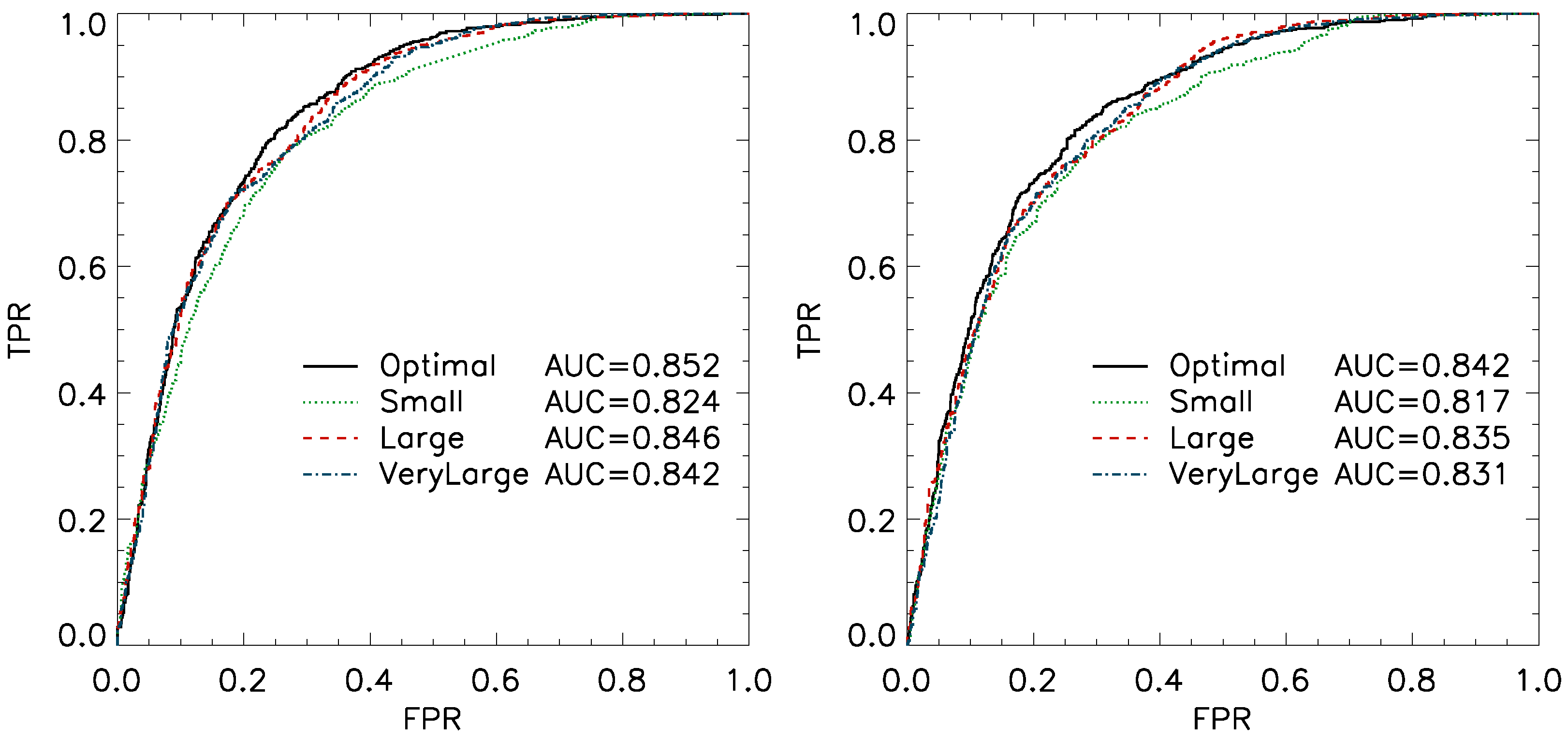
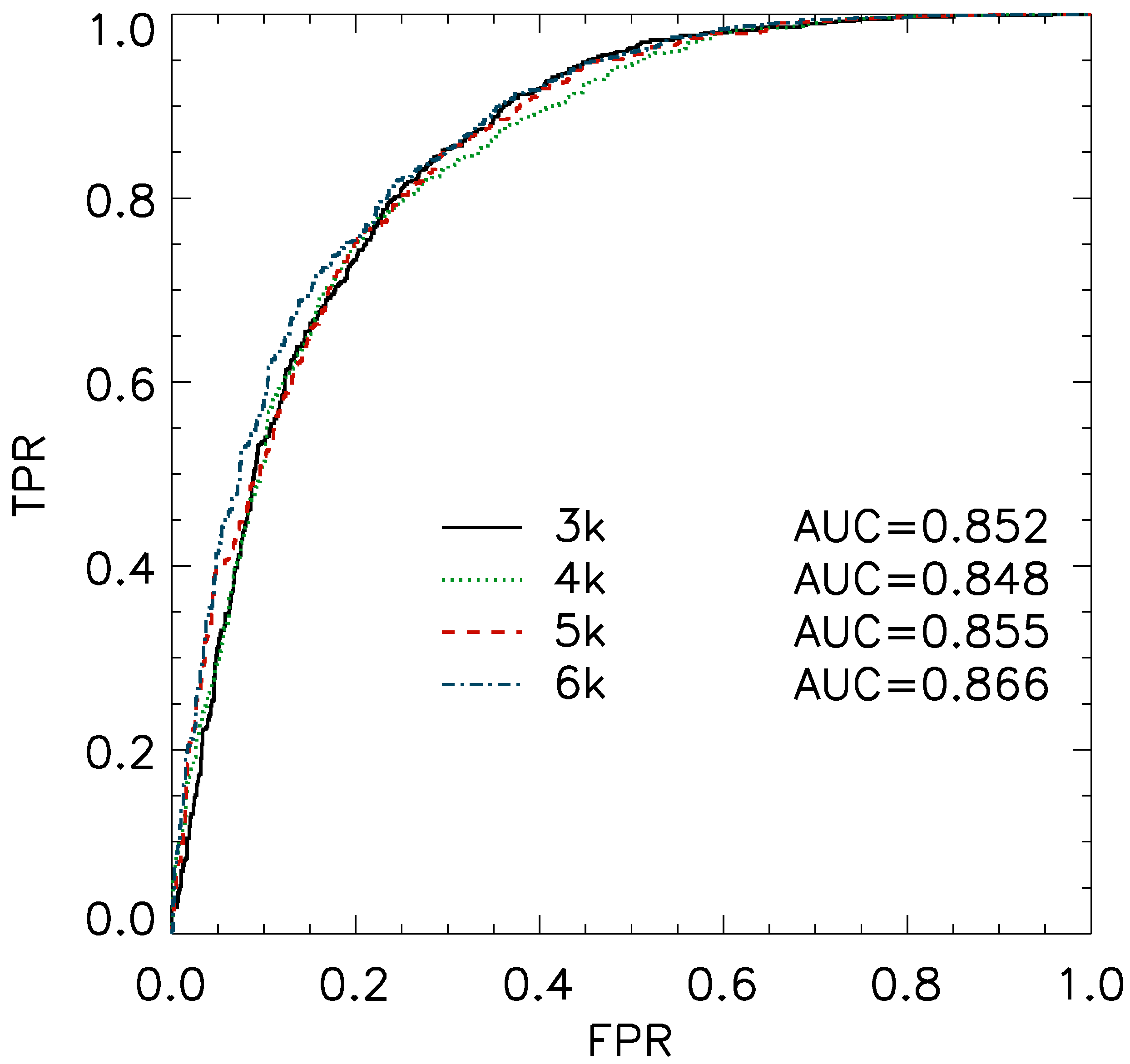
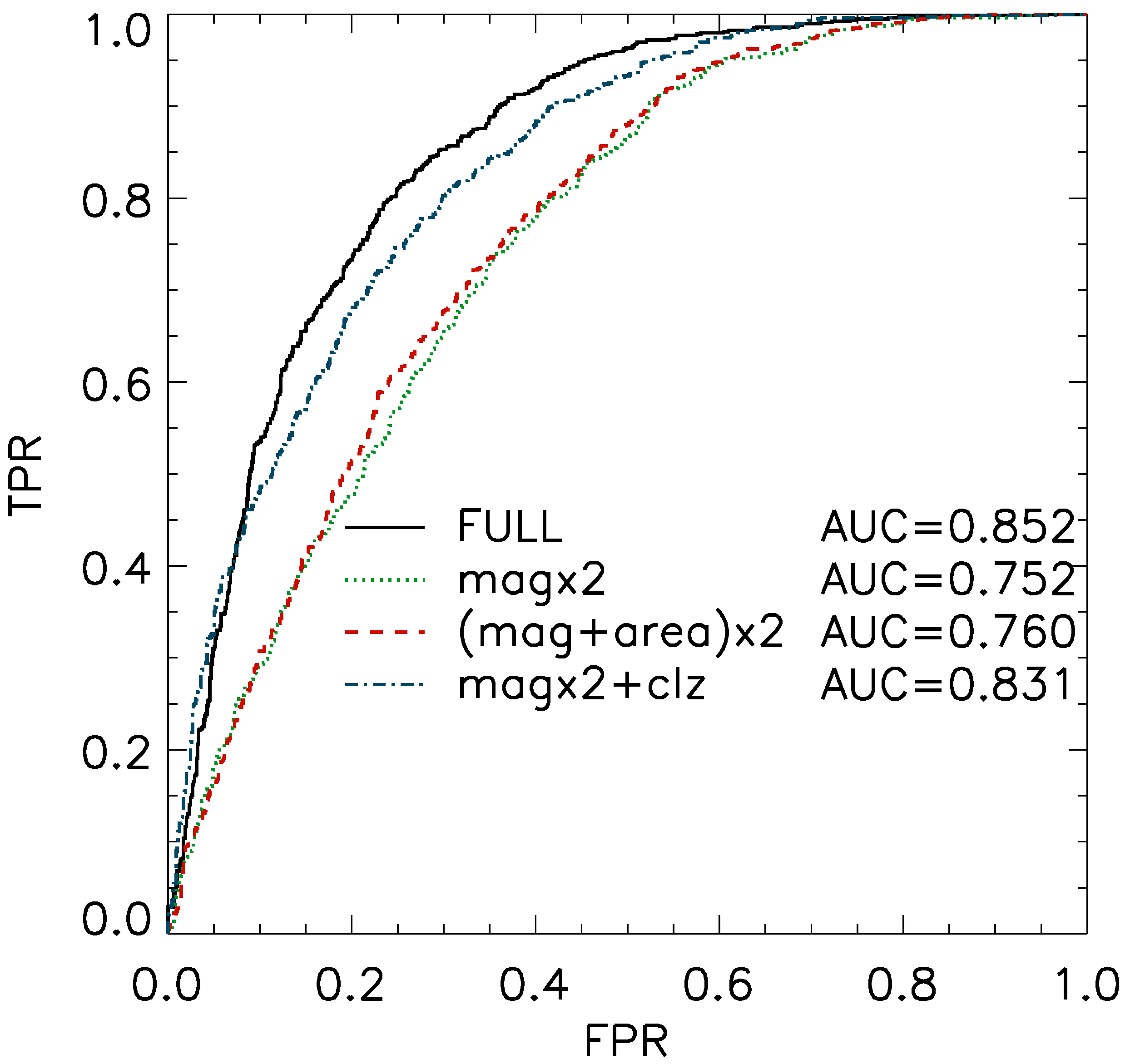
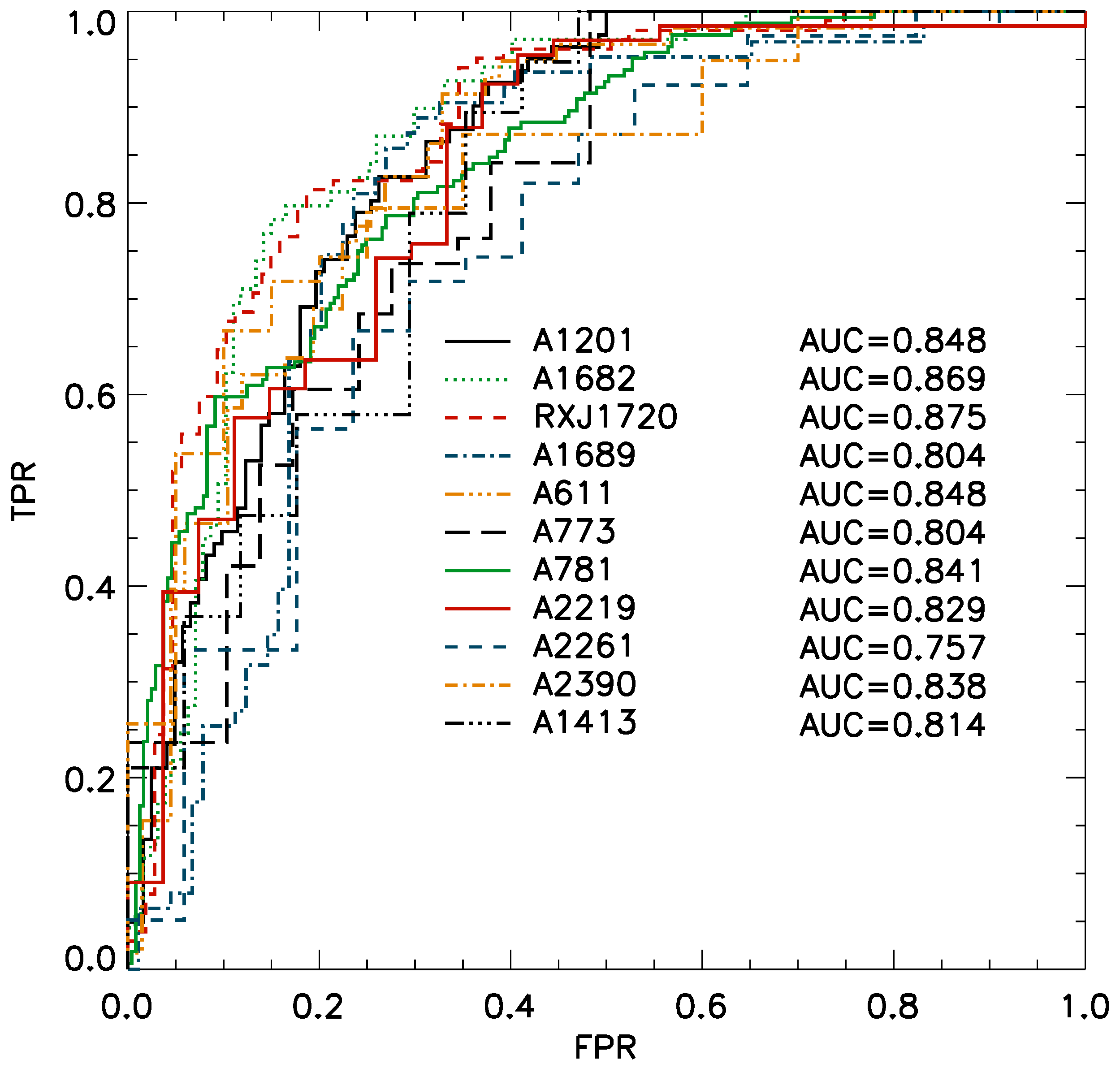
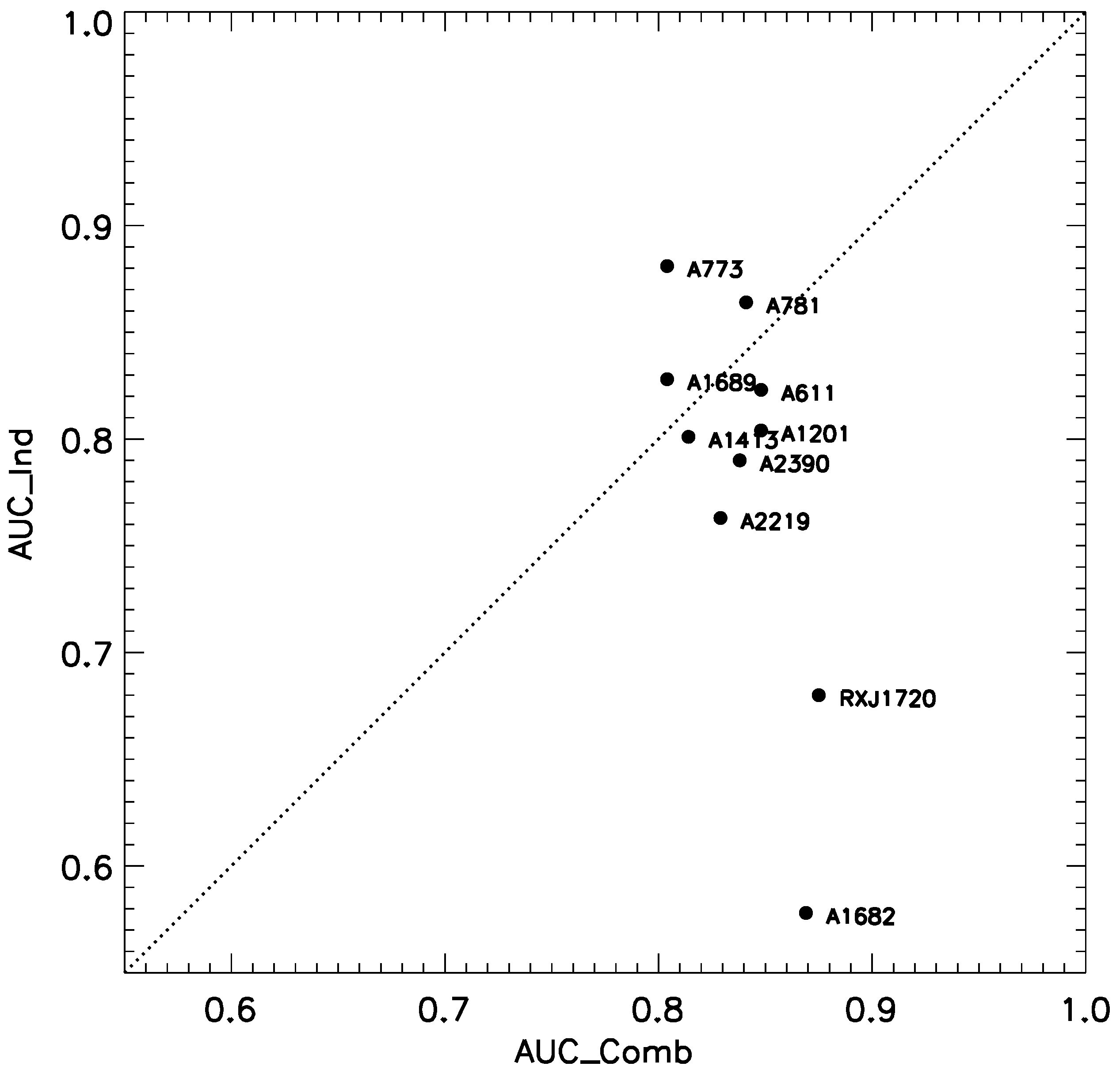
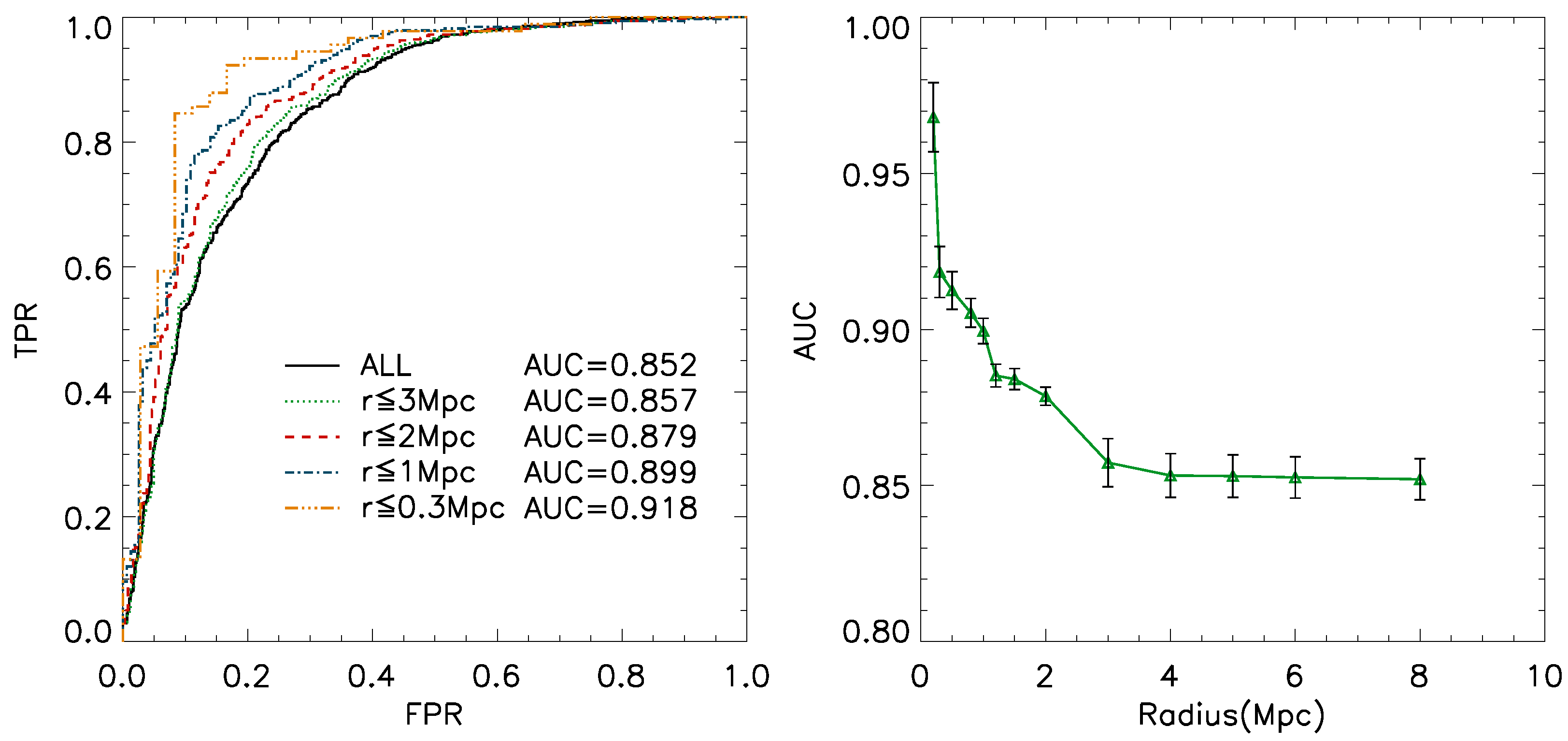
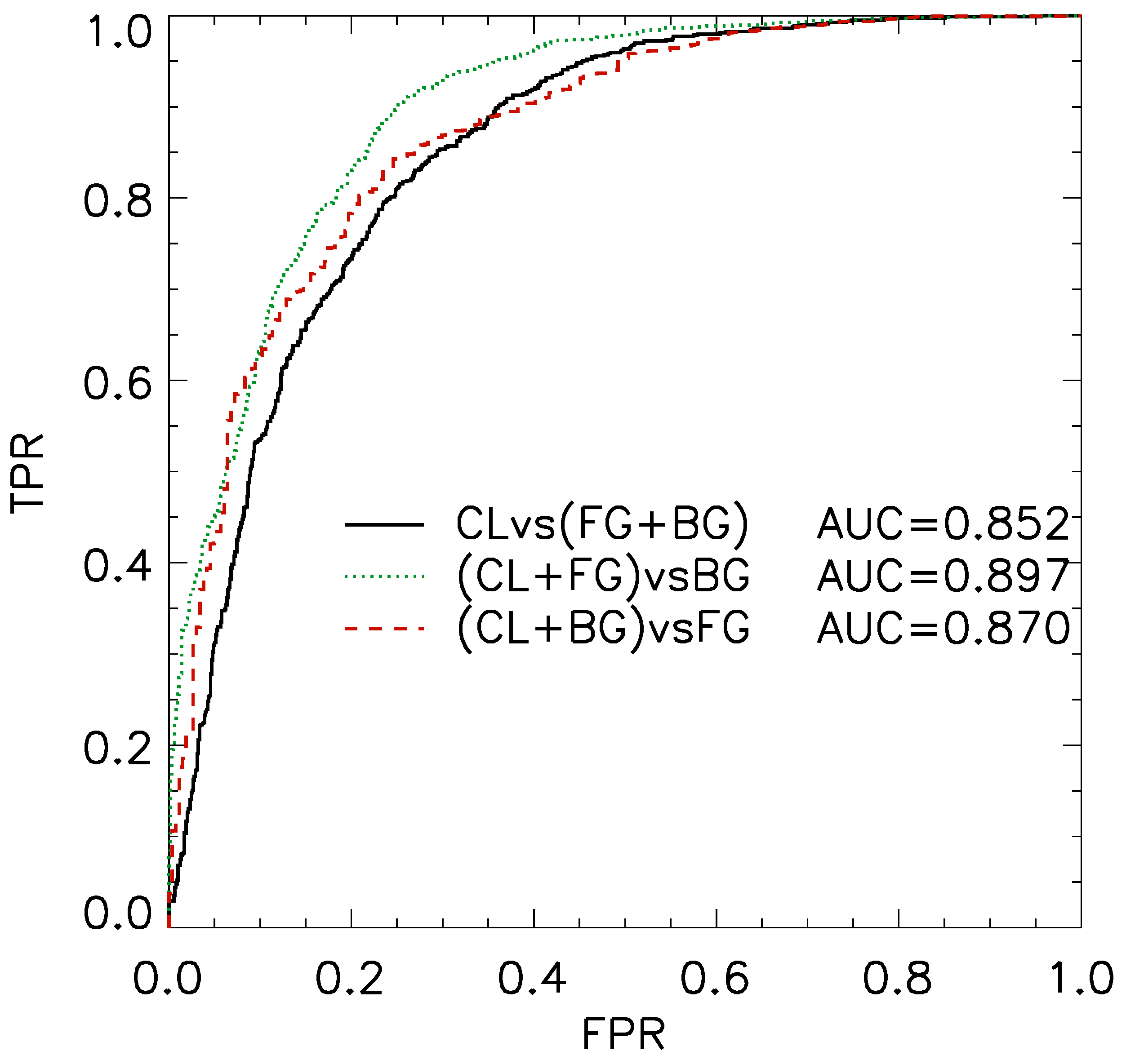


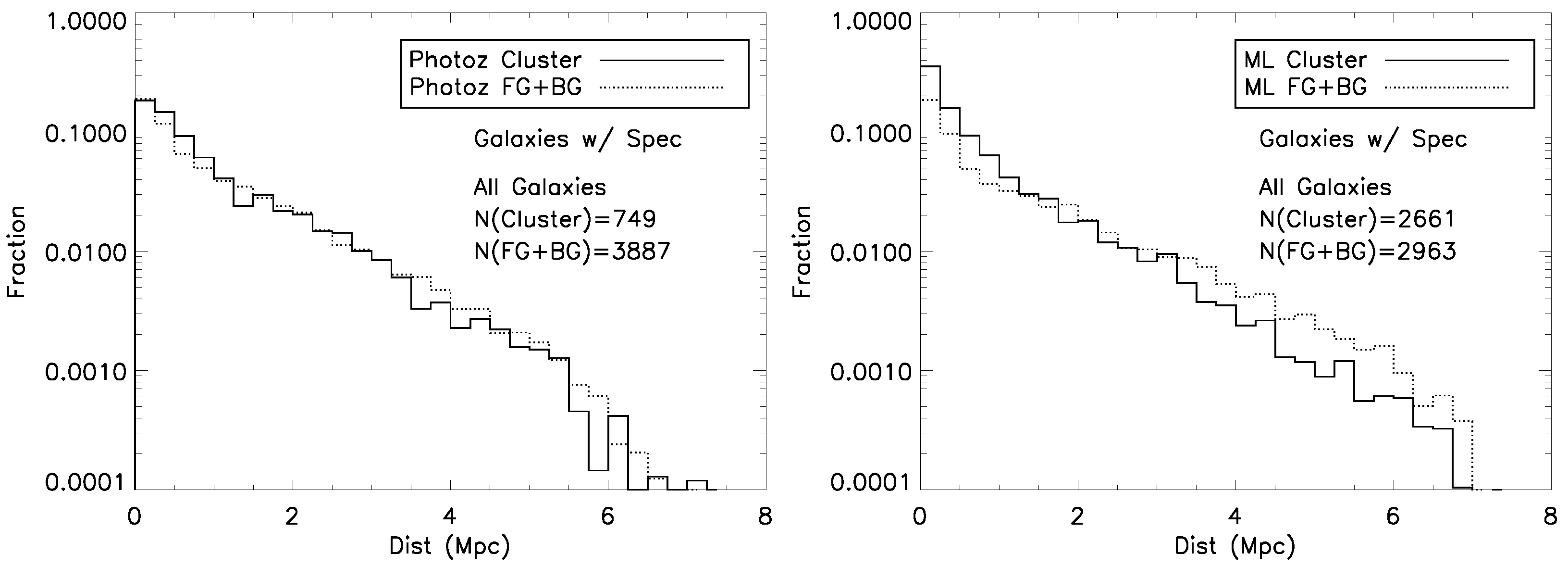
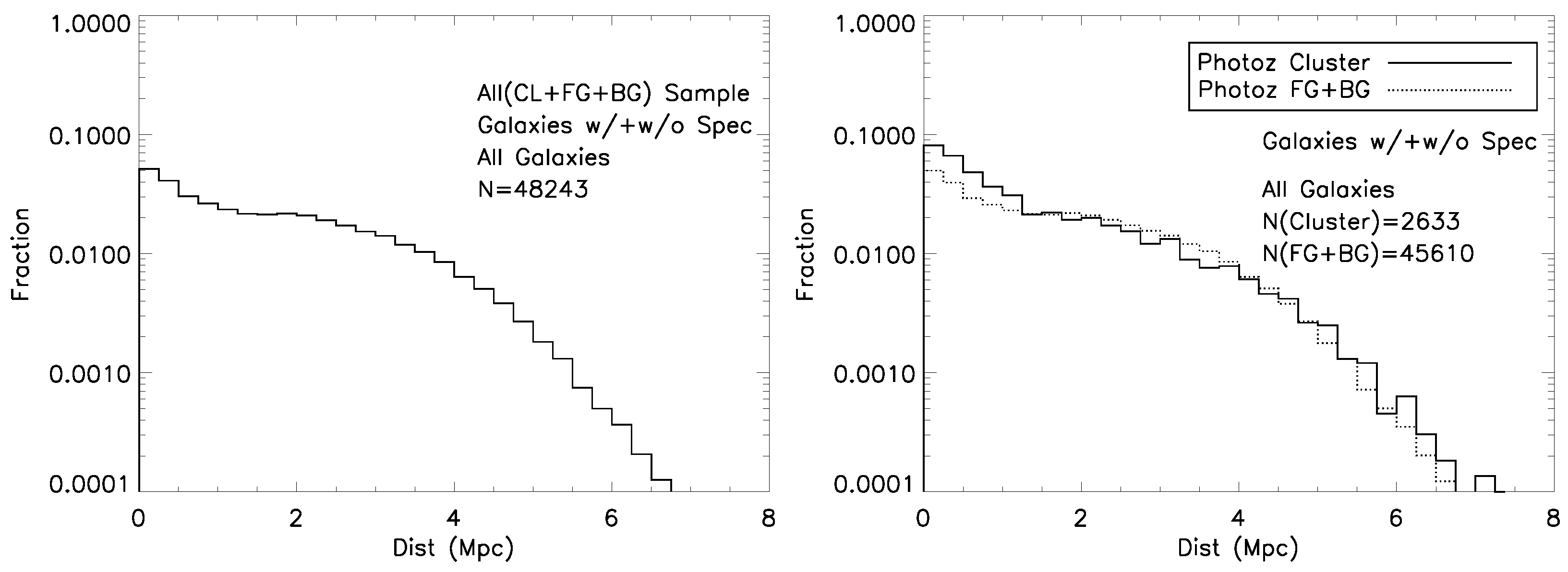

| Cluster | Redshift | No. of Galaxies with Spec | No. of Galaxies |
|---|---|---|---|
| A781 | 0.298 | 1382 | 65,745 |
| RXJ1720 | 0.164 | 718 | 25,961 |
| A1201 | 0.169 | 702 | 21,315 |
| A1682 | 0.226 | 629 | 90,951 |
| A1689 | 0.184 | 481 | 62,682 |
| A611 | 0.288 | 357 | 43,765 |
| A2219 | 0.228 | 315 | 72,506 |
| A773 | 0.217 | 237 | 76,467 |
| A2390 | 0.233 | 209 | 50,036 |
| A2261 | 0.224 | 179 | 65,158 |
| MS1359 | 0.328 | 155 | 28,654 |
| A1413 | 0.142 | 81 | 59,959 |
| ZWCL2701 | 0.214 | 68 | 72,660 |
| RXJ2129 | 0.235 | 59 | 19,959 |
| A1758 | 0.280 | 29 | 31,570 |
| A68 | 0.255 | 23 | 37,153 |
| Name | No. of Measures | Architecture | No. of Trainable Parameters | PU | CO | F1 | AUC |
|---|---|---|---|---|---|---|---|
| Best MLP | 17 | 17 × 53 × 53 × 1 | 3870 | 0.755 | 0.761 | 0.758 | 0.852 |
| Method | Purity | Completeness | F1 | Accuracy |
|---|---|---|---|---|
| Color Selection | 0.565 | 0.916 | 0.699 | 0.631 |
| Red Sequence | 0.671 | 0.777 | 0.720 | 0.717 |
| Five Band Photo-z | 0.808 | 0.257 | 0.390 | 0.598 |
| Color Selection (r ≤ 1.5 Mpc) | 0.722 | 0.924 | 0.811 | 0.725 |
| Red Sequence (r ≤ 1.5 Mpc) | 0.811 | 0.811 | 0.811 | 0.760 |
| Five Band Photo-z (r ≤ 1.5 Mpc) | 0.906 | 0.221 | 0.356 | 0.447 |
| Best MLP | 0.755 | 0.761 | 0.758 | 0.773 |
| Best MLP (r ≤ 1.5 Mpc) | 0.888 | 0.789 | 0.836 | 0.805 |
| Method | Purity | Completeness | F1 | Accuracy |
|---|---|---|---|---|
| Color Selection (Bright) | 0.826 | 0.913 | 0.868 | 0.782 |
| Five Band Photo-z (Bright) | 0.956 | 0.331 | 0.491 | 0.459 |
| Color Selection (Faint) | 0.492 | 0.956 | 0.649 | 0.590 |
| Five Band Photo-z (Faint) | 0.500 | 0.054 | 0.098 | 0.510 |
| Best MLP (Bright) | 0.930 | 0.930 | 0.930 | 0.890 |
| Best MLP (Faint) | 0.913 | 0.677 | 0.778 | 0.865 |
Publisher’s Note: MDPI stays neutral with regard to jurisdictional claims in published maps and institutional affiliations. |
© 2022 by the authors. Licensee MDPI, Basel, Switzerland. This article is an open access article distributed under the terms and conditions of the Creative Commons Attribution (CC BY) license (https://creativecommons.org/licenses/by/4.0/).
Share and Cite
Hashimoto, Y.; Liu, C.-H. Cluster Membership of Galaxies Using Multi-Layer Perceptron Neural Network. Universe 2022, 8, 339. https://doi.org/10.3390/universe8070339
Hashimoto Y, Liu C-H. Cluster Membership of Galaxies Using Multi-Layer Perceptron Neural Network. Universe. 2022; 8(7):339. https://doi.org/10.3390/universe8070339
Chicago/Turabian StyleHashimoto, Yasuhiro, and Cheng-Han Liu. 2022. "Cluster Membership of Galaxies Using Multi-Layer Perceptron Neural Network" Universe 8, no. 7: 339. https://doi.org/10.3390/universe8070339
APA StyleHashimoto, Y., & Liu, C.-H. (2022). Cluster Membership of Galaxies Using Multi-Layer Perceptron Neural Network. Universe, 8(7), 339. https://doi.org/10.3390/universe8070339





